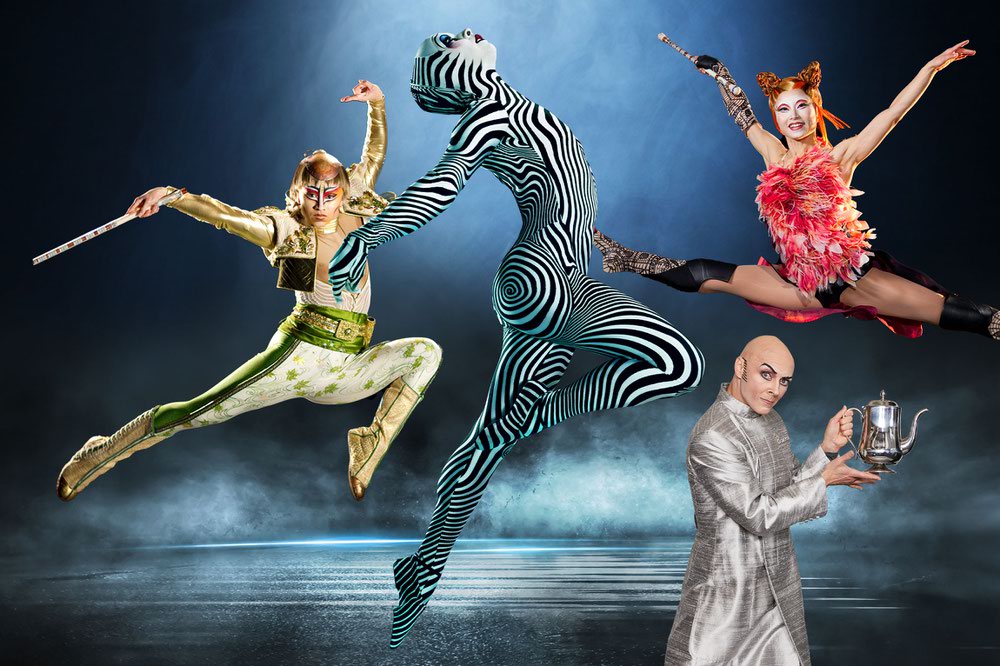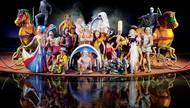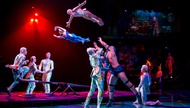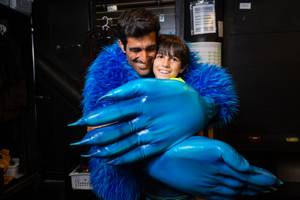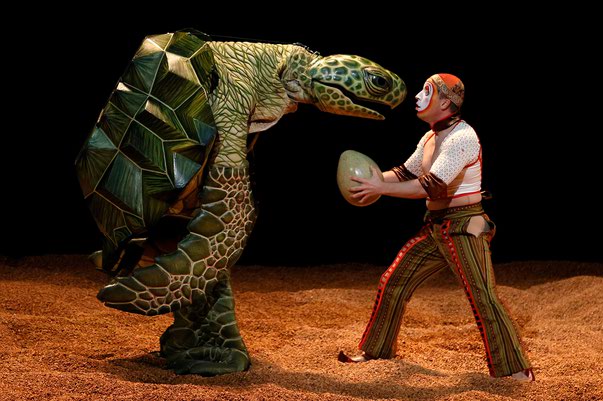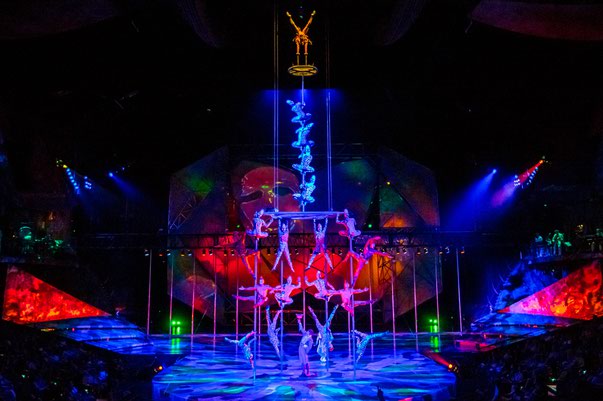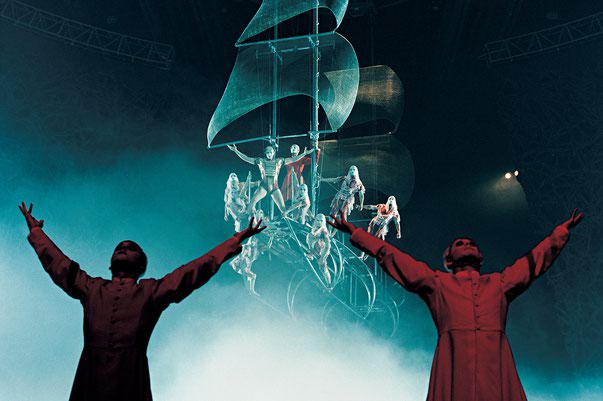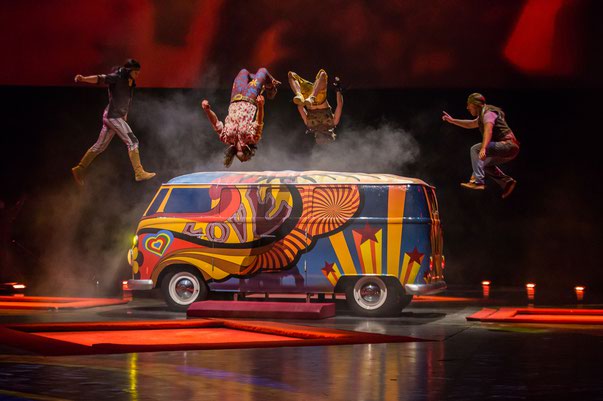The first Cirque du Soleil show I ever saw was Mystère. This was back in springtime 1994, only a few months after the show opened at Treasure Island. Back then, I knew next to nothing about Cirque du Soleil, except that it hailed from Montreal and that it eschewed archetypal circus stuff like animal acts and compact cars crammed full of greasepaint clowns. My ingrained notion of “circus” was so conventional, so American—formed by Circus Circus, one childhood visit to Ringling Bros. and Walt Disney’s Dumbo—that I couldn’t imagine anything outside of it.
All of that changed in one night. Though I’ve seen Mystère many times since then, moments from that first show are still fresh in my memory. I remember the hand balancers, performing their feats of immense strength, balance and grace while perched atop a half-dome. I remember the musical flourishes that accompanied the bungee performers suspended from the ceiling. (I could probably hum much of Mystère’s original 1990s score for you, even now.) I remember Bebe François—originally played by the late, great Francois Dupuis— gleefully interrupting the show while searching the crowd for his “mama.”
But above all else, I remember tearing up, more than once. I wept happily for Mystère, because cheering, applauding, laughing and gasping didn’t feel like sufficient currency for what I was given that night. I didn’t know that I still had a childlike wonderment locked up inside me until Cirque du Soleil found that vault and drilled it open.
RJ Owens, who inherited the Bebe François role, says finding that wonder inside audiences is pretty much a mandate among Cirque performers.
“This may be your 3000th performance, but this is an audience’s first time seeing the show, and if you don’t feel like they feel, think of something that you need to put yourself in that place or think of another career,” he says. “We are creating a memory for the audience that’s going to last an absolute lifetime. There’ll be some things they don’t like—nobody can like everything—but in every Cirque show that I’ve seen, I can pinpoint specific moments that just filled me with such wonder and awe. … [Even] I’m filled with a sense of awe and wonder, every time I go out onstage.”
Many years later, while stuck at home during the pandemic shutdown, I thought about that first Cirque show. I missed lots of things from before COVID, from indie rock gigs to fancy restaurants, but when I imagined being out in the world, I’d always go first to Mystère, because—and I know this sounds dumb—it could never happen in my home. I could imagine Ty Segall playing a set in my backyard, or José Andrés whipping up his Bazaar Meat gazpacho in my dinky kitchen, but Cirque went far beyond any considerations of space, cast and equipment. Owens was right; I had to be there to feel it.
That was likely the first time I’d wondered if I could see all the Las Vegas-based Cirque productions in one week. During those desolate, formless COVID weeks, I had learned that I could easily binge entire seasons of television over the course of a few days. Would it be that much more of a challenge to attend a Cirque show over several consecutive evenings?
It was purely a rhetorical question at the time. All the Vegas Cirque shows were closed, one of them permanently, as it turned out (New York-New York’s Zumanity, which, regrettably, I never saw), and Cirque du Soleil itself filed for bankruptcy protection in June 2020. (To be fair, nearly every entertainment company was driven to the brink by COVID, save for Netflix.) Dejectedly, I wondered if the Cirque du Soleil shows I’d seen over the years—Mystère, O and the now-defunct Zarkana—would be all the Cirque I’d ever get.
Cirque thought otherwise. “There was never a doubt that we would come back; it was just a matter of when,” says Eric Grilly, president of Cirque du Soleil’s Resident and Affiliate shows divisions, via email. “We are inherently risk takers. With strong partners and the vast playground of the Las Vegas Strip, we’re able to explore the bounds of our creativity.”
Cirque’s full return to that playground, cemented with the reopening of KÀ in November 2021 and the May 2022 debut of Mad Apple in the former Zumanity theater at New York-New York in May, heartened me as few comebacks ever have. Cirque du Soleil is arguably the sturdiest pillar of Vegas entertainment. It’s one of our best-known cultural attributes, alongside Elvis and electricity. And as anyone who has watched a lot of streaming TV can tell you, six 90-minute shows make for a proper “season.” Once again, I realized, Cirque could be binged—and this time, I would do it.
I set a few rules for myself at the outset. I would see only Cirque du Soleil-branded shows, skipping those owned by the company but without the Cirque name on them, such as Blue Man Group. I had to see all their productions in six days. (I did it in five.) And even though already I’d seen three of the shows (I checked out Mad Apple in previews), I would proceed like Bebe François, approaching every show as if it were the first time. I’d put away the notebook, quash my natural skepticism and lean right into the wonder and awe.
Night 1: KÀ
KÀ came first. The MGM Grand show, which takes place inside a breathtakingly colossal theater whose wings are lined with catwalks and steampunk-like metal scaffolding, had the strongest story of the six shows I attended during my binge. (Granted, all the Vegas Cirque shows have narrative throughlines save for Mad Apple, which I’ll talk about momentarily.) It’s possible, and even easy, to watch these shows without giving much consideration to who’s who and who wants what, simply drinking in the spectacle.
But KÀ is different. It has obvious heroes and villains, all of whom go through dynamic, often dangerous physical trials. Throughout KÀ, we see our young protagonists faced with one hardship after the next—ambushes, shipwrecks and many, many battles, each one unique. The table-like main stage, a technological marvel that can tilt and rotate in pretty much any direction, can be made to be anything—a barge lazily drifting downriver, or a sheer cliff face where rappelling soldiers fight each other to the death. At one point, archers fire arrows from the wings, which through mechanical magic “stick” in the cliff face; they become grips that a character uses to climb the wall.
I was slack-jawed for most of KÀ, oftentimes too impressed even to applaud the individual performers. Like all Cirque shows, KÀ contains a vast array of specialty performers—aerialists, acrobats, martial artists, clowns. But the way they’re employed in KÀ feels less theatrical and more cinematic. It’s one thing to have a “Wheel of Death” act in your show, but quite another to have two of them, one in front of another, being moved in opposite directions like clockwork. Many bits of KÀ reminded me of recent action movies I’ve seen, like Mad Max: Fury Road and Shang-Chi. It didn’t occur to me until I left the theater that this 2005 show might have partially inspired the action in those movies, not the other way around.
KÀ presented me with a gift—watching skilled, conditioned entertainers doing their jobs while distraction erupts all around them. And I watch the performers watching other performers, making sure they’re safe and priming themselves to step in if something goes wrong with an act or a set piece.
Mystère’s Owens says audiences barely see the half of it. “What you don’t see is the people backstage, off-stage, upstage, downstage, above us, behind us and to the side of us who are also watching out,” he says. “We are one giant, lovely dysfunctional family, and family should always be watching out for each other. It’s safe to say that if you’re of the mindset that you only look out for yourself onstage, you’re not gonna last long in a Cirque show. We rely on each other so much.”
Night 2: MICHAEL JACKSON ONE & MAD APPLE
My second night was a south-Strip double-header of Michael Jackson One at Mandalay Bay, followed by Mad Apple at New York-New York. Originally, my whole week was supposed to be like that: Two shows nightly, in the order the shows made their debut. Meaning, I would have attended Mystère (December 1993) and O (October 1998) on Night 1, KÀ (February 2005) and The Beatles Love (June 2006) on night 2 and Michael Jackson One (June 2013) and Mad Apple on night 3. I had doubts about being able to get from KÀ to Love in time for curtain, so I rescheduled them for individual nights, and in so doing, upset the three-night plan.
But a three-night Cirque binge is entirely possible, and I recommend trying it, because there are unexpected advantages to seeing Cirque shows back-to-back. For example, after seeing One and Mad Apple on the same night, I realized how many of Cirque’s special-sauce performers—the truly unexpected acts—aren’t acrobats, aerialists or clowns.
Take One. As you’d expect of a show celebrating one of the greatest performers in history, a man whose singing was inseparable from his dancing, One employs multiple forms of performance, many of which you’d never see in a traditional circus. Dancers faithfully reproduce nearly every move for which Jackson was known, from the Moonwalk to the “Smooth Criminal” lean. A powerhouse live singer appears during multiple songs, sometimes harmonizing with Jackson’s recorded tracks, sometimes performing a duet. She floats over the audience seated in a crescent moon—a beautiful touch.
(A disclaimer: Michael Jackson One made me feel uncomfortable for reasons unrelated to Cirque. While its interpretation of Jackson’s career, both onstage and off, is nothing short of lyrical—and no one can deny the immortal appeal of his greatest songs—my appreciation of the show is qualified by the ugly controversy surrounding Jackson’s life, and that’s all I’ll say about it. But if any of that stuff weighed heavily on the young fans seated around me, they didn’t show it. They sang along with every number, and some even cried loudly during a late-show surprise that made clever use of digital projection.)
Mad Apple is something else again. This New York-themed production is as close as Cirque comes to a straight variety show. The acts are introduced one at a time, the live band is central to the action and a stand-up comic works the crowd between setups. The performers include singers, dancers, sign-spinners, magicians and a woman who executes a graceful aerial routine while hanging from her hair. One fast-paced sequence has a team of street ballers launching into running jumps from a trampoline and nailing perfect dunks before landing.
“Shows come together in different ways, [with] inspiration from many places,” Grilly says. “Our casting team is constantly scouring the Earth for the best of the best to join our shows. Our stages provide a life after competition for athletes, and a space for creative expression that competing generally does not allow.”
Another unusual thing about Mad Apple is that the show tells you what it is, generally a Cirque no-no. And while the production doesn’t exactly poke fun at itself, there’s an irreverence to the proceedings that tells the audience that this is a party above all else. (The onstage bars, which stay open until the very moment the show begins, reinforce that message.)
As a result, Mad Apple is a good show for first-timers who’ve formed an opinion of Cirque du Soleil without ever experiencing it. That said, it’s not the Cirque show I recommend to most first timers. That would be the following night’s show.
Night 3: Mystère
“If I ever hear anybody say, ‘we’re coming to Vegas, and we’ve never seen a Cirque show,’ I always tell them to see Mystère,” RJ Owens says. “I’m adamant about this, [because] it is a show that still embraces the original concept of Cirque du Soleil. It embraces the performer; it is all about human existence and the human condition onstage. It’s not about the set, or the lights, or the sound. All those things are just part of this beautiful show.
“People will often say to me, ‘Oh, you’re the star of the show.’ I’m like, ‘No, I’m not; Mystère is the star of the show.’ … It is where you see beauty and grace and grit and determination and hearts and strength and power, beautifully crafted into a visual spectacle that will fill you with a sense of wonder and awe that you haven’t had in years.”
What he said. Nearly 30 years after I first saw Mystère, it still affects me. The taiko drummers descending from the ceiling, the teeterboard jumpers and, yes, Bebe François—it all feels new to me, because it seems new to the performers, too. They act as if they stepped onstage without knowing exactly why they had done it, without knowing they were capable of making art with their bodies until they’d begun doing it.
As a singular personality, Mystère is guileless, wide-eyed, constantly elated. It’s easy to believe in, because it’s aimed squarely at the part of us that wants to believe in a world of miracles. If you want to know if you still possess that quality, Mystère will root it out for you.
NIGHT 4: O
I first saw O only a few years ago, in late 2019. I came out of the show in a state of loopy astonishment, which, at the time, I attributed to the monster scale of the production. Everything about O is a wow: its cast is massive, its theater feels as large as the Bellagio itself, and its stage, dominated by a giant pool that can become a flat, dry platform in a matter of seconds, must be seen to be believed. But on my second viewing, I understood that what had impressed me so wasn’t the size of the stage, but how O fills every inch of that stage with activity.
You’re never quite sure what to look at. Look too closely at the performers on swimming carousel horses and you might miss the woman playing a rolling cello, or the grumpy man trying to read a newspaper while engulfed in flames. (One of my favorite blink-and-you’ll-miss-it moments is both a behind-the-scenes look and a great joke: At one point the platform rises out of the water with several of the show’s safety divers trapped on it, flapping like beached fish.) It’s stage magic in its broadest form; O is expert at diverting your attention while it sets up a new act. More than once I was startled by the seemingly sudden appearance of performers and equipment. Where did that come from?
That said, there are acts in O that ask you to narrow your focus. To me, the clowns Leonid and Valery have the most lovely and poignant story arc in the show, or in any of the Vegas Cirque shows for that matter. Adrift on a floating shack, they go through the whole lost-at-sea schtick; they fight the elements, they plug up leaks, they try fruitlessly to get a good night’s sleep.
Finally, out of boredom, they teach each other to dance, and in so doing reveal their genuine affection for one another. It’s a wordless, heart-rending moment that you can read from the back of the house, through a masterful combination of performance and staging.
Night 5: The Beatles Love
Fittingly, The Beatles Love—which, despite the sale of its host resort, will continue at the Mirage at least through the end of 2023—was the final stop of what amounted to nothing less than a magical mystery tour. Love was the show I was most curious about before I began my Cirque binge, and it didn’t disappoint.
I was already a fan of its soundtrack—a mashup-inspired medley of Beatles hits, deconstructed, remixed and re-contextualized by George and Giles Martin—and it’s employed to perfection in a multidisciplinary spectacular that pulls out pretty much every trick in the book. The show features aerial acts, dance routines, roller skaters, projection screens and a moment of … hmm, let’s call it audience envelopment, whose particulars I won’t spoil. It gave me first-time Mystère feeling again.
But throughout Love, a thought was turning in the back of my head: What was I taking away from this five-night headstand? Had I learned anything from doing this all-at-once approach, as opposed to seeing the shows over a period of weeks or even months? As Love’s final performer left the stage, I began to put it all together.
The first thing I knew was that I could do it again. I wanted to do it again, to see everything I’d missed the first or second time. Sure, I could watch all of Game of Thrones again and maybe pick up a new character moment or spot an interesting background element that had slipped past me on first viewing. But those beats are stuck on a track; it’ll never change. Cirque du Soleil’s brand of entertainment is built on things not being where you expect them to be or doing what you expect them to do. I could watch O or KÀ a hundred times and never see the same show, since acts are modified and performers are swapped in and out. Even the audience has it in its power to subtly change what’s happening onstage.
Also, I understood that the common thread uniting all the shows isn’t their stories or structure, or even the circus acts themselves. The common element, as RJ Owens says, is wonder and awe. There’s no hard and fast template for Cirque shows, other than bringing the audience to that place where it can let go of preconceptions and cynicism and simply be overwhelmed.
“Our shows provide people with a 90-minute escape into another world,” Grilly says. “Especially coming out of the pandemic, there’s such a need and demand for live experiences and human connection.”
And the binge confirmed what I already suspected: Vegas needs Cirque du Soleil. Putting aside how Cirque transformed the way people look at Las Vegas, the company is, at its most basic level, an industrial-strength employer—the mind boggles at the number of sound and lighting technicians, safety personnel, physical therapists, trainers and more needed to produce just one Love-sized effort, let alone six of them. It’s not a workforce, so much as a population.
And that population has changed the rest of the city, too—the parts tourists never see. Over the years, I’ve lost count of how many charitable events, community stage productions and even gallery shows have benefited from having this international crew living and working in our Valley. The camaraderie that binds these performers and technicians on the job doesn’t end when the curtain drops; they take it out into the world, and make good things happen with it.
“Over the last two years, things have changed so much, but I have to say that the one constant, probably the only reason why we’re still surviving, is the people,” Owens says. “It is the technicians; it is the artists; it is the ushers; it is the PR people; it is the company itself. Cirque is made up of an extraordinary group of people who are so passionate about their respective duties that they can’t not put out something of exceptional quality. I don’t think it’s in our DNA to put out something that is not going to make you have the feels.”
Click HERE to subscribe for free to the Weekly Fix, the digital edition of Las Vegas Weekly! Stay up to date with the latest on Las Vegas concerts, shows, restaurants, bars and more, sent directly to your inbox!
